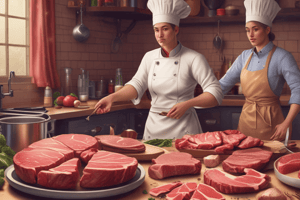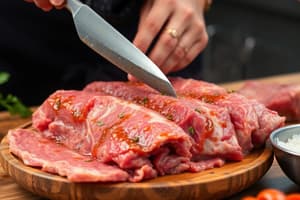Podcast
Questions and Answers
What are popular tender cuts of meat?
What are popular tender cuts of meat?
- Ribeye steaks, pork chops, lamb loin (correct)
- Beef tenderloin, pork tenderloin, lamb tenderloin
- Beef shank, pork shoulder, lamb leg
- Beef flanks, pork belly, lamb breast
What are the methods for tenderizing meat?
What are the methods for tenderizing meat?
- Boiling, freezing, fermenting, drying
- Mechanical, chemical, cutting, use of acid (correct)
- Steaming, stewing, microwaving, smoking
- Grilling, baking, broiling, sautéing
Which nutrients are high in meat?
Which nutrients are high in meat?
- Fiber, protein, vitamin A, vitamin D, vitamin E
- Carbohydrates, fat, vitamin B12, vitamin K, folate
- Iron, zinc, phosphorus, thiamin, riboflavin, niacin (correct)
- Sodium, potassium, calcium, magnesium, vitamin C
At what temperature should ground beef be cooked to?
At what temperature should ground beef be cooked to?
What are examples of dry heat cooking techniques?
What are examples of dry heat cooking techniques?
What are examples of moist heat cooking techniques?
What are examples of moist heat cooking techniques?
At what temperature should poultry be cooked to?
At what temperature should poultry be cooked to?
What happens to properly cooked meats?
What happens to properly cooked meats?
How should meat be stored before use or freezing?
How should meat be stored before use or freezing?
Meat is the edible muscle of animals, typically cattle, sheep, and pigs.
Meat is the edible muscle of animals, typically cattle, sheep, and pigs.
Name one example of a moist heat cooking technique.
Name one example of a moist heat cooking technique.
What is an example of a dry heat cooking technique?
What is an example of a dry heat cooking technique?
Name two ways to tenderize tough cuts of meat.
Name two ways to tenderize tough cuts of meat.
Why might some people opt for vegan or alternative meat products?
Why might some people opt for vegan or alternative meat products?
______ can be flavoring or tenderizing, using acidic ingredients like lemon juice, vinegar, or tenderizing enzymes from ginger, pineapple, papaya, kiwi, and figs
______ can be flavoring or tenderizing, using acidic ingredients like lemon juice, vinegar, or tenderizing enzymes from ginger, pineapple, papaya, kiwi, and figs
______ is made from plant-based ingredients like peas or soy from soybeans
______ is made from plant-based ingredients like peas or soy from soybeans
Match the meat cooking technique with its description:
Match the meat cooking technique with its description:
Flashcards are hidden until you start studying
Study Notes
Meat Preparation and Cooking Techniques
- Vegan meat is made from plant-based ingredients like peas or soy from soybeans
- Consider family appetites, storage, time, servings, and budget when buying meat
- Meat should be refrigerated, placed in a plastic bag, and used or frozen by the label date
- Properly cooked meats become firm, tender, and juicy, while overcooked meats become tough and dry
- Before cooking, trim visible fat and thaw frozen raw meat, using the refrigerator, cool water, or microwave
- Doneness is the point at which meat is flavorful and safe to eat, best tested with a meat thermometer
- Ground meat internal temperatures: beef, veal, lamb, and mixtures at 160°, medium rare at 145°, medium at 160°, well done at 170°
- Poultry and leftovers internal temperatures: fresh (raw) at 160°, reheated precooked ham at 140°, chicken, turkey, duck, goose, and casseroles at 165°
- Various meat recipes include pork quesadillas, seared pork medallions, beef tacos, orange chicken, beef kebabs, and pizza on the grill
- Dry heat cooking techniques include roasting, pan-frying, broiling, grilling, pan-broiling, microwave frying, and baking
- Moist heat cooking techniques include braising, simmering, steaming, and pressure cooking
- Marinades can be flavoring or tenderizing, using acidic ingredients like lemon juice, vinegar, or tenderizing enzymes from ginger, pineapple, papaya, kiwi, and figs.
Meat Preparation and Cooking Techniques
- Vegan meat is made from plant-based ingredients like peas or soy from soybeans
- Consider family appetites, storage, time, servings, and budget when buying meat
- Meat should be refrigerated, placed in a plastic bag, and used or frozen by the label date
- Properly cooked meats become firm, tender, and juicy, while overcooked meats become tough and dry
- Before cooking, trim visible fat and thaw frozen raw meat, using the refrigerator, cool water, or microwave
- Doneness is the point at which meat is flavorful and safe to eat, best tested with a meat thermometer
- Ground meat internal temperatures: beef, veal, lamb, and mixtures at 160°, medium rare at 145°, medium at 160°, well done at 170°
- Poultry and leftovers internal temperatures: fresh (raw) at 160°, reheated precooked ham at 140°, chicken, turkey, duck, goose, and casseroles at 165°
- Various meat recipes include pork quesadillas, seared pork medallions, beef tacos, orange chicken, beef kebabs, and pizza on the grill
- Dry heat cooking techniques include roasting, pan-frying, broiling, grilling, pan-broiling, microwave frying, and baking
- Moist heat cooking techniques include braising, simmering, steaming, and pressure cooking
- Marinades can be flavoring or tenderizing, using acidic ingredients like lemon juice, vinegar, or tenderizing enzymes from ginger, pineapple, papaya, kiwi, and figs.
Meat Preparation and Cooking Techniques
- Vegan meat is made from plant-based ingredients like peas or soy from soybeans
- Consider family appetites, storage, time, servings, and budget when buying meat
- Meat should be refrigerated, placed in a plastic bag, and used or frozen by the label date
- Properly cooked meats become firm, tender, and juicy, while overcooked meats become tough and dry
- Before cooking, trim visible fat and thaw frozen raw meat, using the refrigerator, cool water, or microwave
- Doneness is the point at which meat is flavorful and safe to eat, best tested with a meat thermometer
- Ground meat internal temperatures: beef, veal, lamb, and mixtures at 160°, medium rare at 145°, medium at 160°, well done at 170°
- Poultry and leftovers internal temperatures: fresh (raw) at 160°, reheated precooked ham at 140°, chicken, turkey, duck, goose, and casseroles at 165°
- Various meat recipes include pork quesadillas, seared pork medallions, beef tacos, orange chicken, beef kebabs, and pizza on the grill
- Dry heat cooking techniques include roasting, pan-frying, broiling, grilling, pan-broiling, microwave frying, and baking
- Moist heat cooking techniques include braising, simmering, steaming, and pressure cooking
- Marinades can be flavoring or tenderizing, using acidic ingredients like lemon juice, vinegar, or tenderizing enzymes from ginger, pineapple, papaya, kiwi, and figs.
Meat Preparation and Cooking Techniques
- Vegan meat is made from plant-based ingredients like peas or soy from soybeans
- Consider family appetites, storage, time, servings, and budget when buying meat
- Meat should be refrigerated, placed in a plastic bag, and used or frozen by the label date
- Properly cooked meats become firm, tender, and juicy, while overcooked meats become tough and dry
- Before cooking, trim visible fat and thaw frozen raw meat, using the refrigerator, cool water, or microwave
- Doneness is the point at which meat is flavorful and safe to eat, best tested with a meat thermometer
- Ground meat internal temperatures: beef, veal, lamb, and mixtures at 160°, medium rare at 145°, medium at 160°, well done at 170°
- Poultry and leftovers internal temperatures: fresh (raw) at 160°, reheated precooked ham at 140°, chicken, turkey, duck, goose, and casseroles at 165°
- Various meat recipes include pork quesadillas, seared pork medallions, beef tacos, orange chicken, beef kebabs, and pizza on the grill
- Dry heat cooking techniques include roasting, pan-frying, broiling, grilling, pan-broiling, microwave frying, and baking
- Moist heat cooking techniques include braising, simmering, steaming, and pressure cooking
- Marinades can be flavoring or tenderizing, using acidic ingredients like lemon juice, vinegar, or tenderizing enzymes from ginger, pineapple, papaya, kiwi, and figs.
Meat Preparation and Cooking Techniques
- Vegan meat is made from plant-based ingredients like peas or soy from soybeans
- Consider family appetites, storage, time, servings, and budget when buying meat
- Meat should be refrigerated, placed in a plastic bag, and used or frozen by the label date
- Properly cooked meats become firm, tender, and juicy, while overcooked meats become tough and dry
- Before cooking, trim visible fat and thaw frozen raw meat, using the refrigerator, cool water, or microwave
- Doneness is the point at which meat is flavorful and safe to eat, best tested with a meat thermometer
- Ground meat internal temperatures: beef, veal, lamb, and mixtures at 160°, medium rare at 145°, medium at 160°, well done at 170°
- Poultry and leftovers internal temperatures: fresh (raw) at 160°, reheated precooked ham at 140°, chicken, turkey, duck, goose, and casseroles at 165°
- Various meat recipes include pork quesadillas, seared pork medallions, beef tacos, orange chicken, beef kebabs, and pizza on the grill
- Dry heat cooking techniques include roasting, pan-frying, broiling, grilling, pan-broiling, microwave frying, and baking
- Moist heat cooking techniques include braising, simmering, steaming, and pressure cooking
- Marinades can be flavoring or tenderizing, using acidic ingredients like lemon juice, vinegar, or tenderizing enzymes from ginger, pineapple, papaya, kiwi, and figs.
Studying That Suits You
Use AI to generate personalized quizzes and flashcards to suit your learning preferences.




